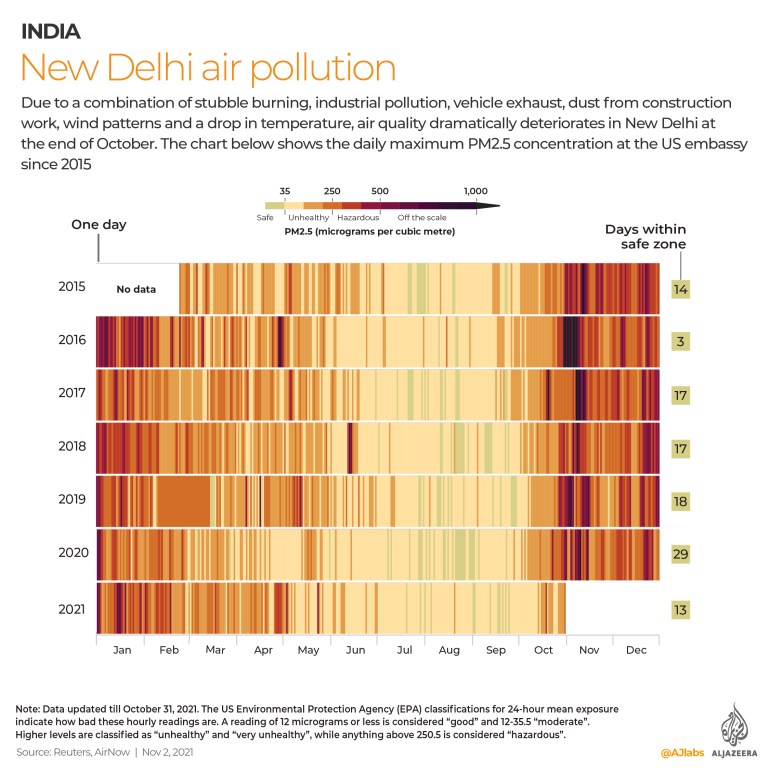India celebrates Diwali amid air pollution, COVID fears
The celebrations last year were upended by a renewed spike in COVID-19 infections, but festivities this year seem to be back.

Indians across the country are celebrating Diwali, the festival of lights, amid concerns over the coronavirus pandemic and rising air pollution.
Diwali is typically celebrated by socialising and exchanging gifts with family and friends. Many light oil lamps or candles to symbolise a victory of light over darkness, and fireworks are set off as part of the celebrations.
Keep reading
list of 3 itemsDiwali: The festival of lights
After rare clean spell, air quality set to drop in Indian capital
Last year, celebrations in India were upended by a renewed spike in COVID-19 infections, but festivities this year seem to be back.
Even though the government has asked people to avoid large gatherings, markets have been buzzing ahead of Diwali, with eager crowds buying flowers, lanterns and candles.
As dusk fell on Wednesday, more than 900,000 earthen lamps were lit and kept burning for 45 minutes in the northern city of Ayodhya in Uttar Pradesh state, retaining the Guinness World Record it set last year.
As part of the Diwali celebrations, the city last year lit 606,569 oil lamps.
The lamps were lit at Ram ki Pauri, at the banks of Saryu River, a stunning spectacle for thousands of visitors who thronged its shores while ignoring coronavirus social-distancing norms.

A laser and fireworks show followed, illuminating the city’s lanes and river banks. Thousands of city residents also lit lamps at their houses and temples.
The festival is being celebrated at a time when India’s pandemic crisis has largely subsided.
On Friday, the country recorded nearly 13,000 new coronavirus cases and 461 deaths, a far cry from earlier this year when India buckled under a few hundred thousand new infections every day.
Overall, it has recorded more than 35 million infections and more than 459,000 deaths, according to the health ministry. These figures, as elsewhere, are likely to be underestimated.

Even states where infections were swelling a few weeks ago, such as Kerala along the tropical Malabar Coast, have seen a sustained decline.
India also celebrated administering its billionth COVID-19 vaccine dose last month, further boosting confidence that life is returning to normal.
Still, experts have warned that the festival season could bring a renewed spike in infections if COVID-19 health measures are not enforced.

Toxic smog chokes Indian capital
There are also worries over air pollution, which typically shrouds northern India under a toxic grey smog at this time as temperatures dip and winter settles in.
On Diwali night, people also light up the sky with firecrackers – their smoke causing pollution that takes days to clear.
India’s capital was choked in a shroud of thick, toxic smog on Thursday as millions gathered with family and friends to celebrate the festival.
New Delhi is ranked as one of the most polluted cities globally, with a hazardous melange of factory emissions, car exhaust and smoke from agricultural fires settling in the skies over its 20 million people each winter.
A 2020 report by Swiss organisation IQAir found 22 of the world’s 30 most polluted cities were in India, with New Delhi ranked the most polluted capital globally.
The same year, the Lancet said 1.67 million deaths were attributable to air pollution in India in 2019, including almost 17,500 in the capital.

People across the sprawling city woke up on Thursday to find themselves enveloped in a grey-yellow blanket of haze, with experts warning of worse to come in the days ahead.
Levels of PM2.5 – the smallest and most harmful particles polluting the air – peaked at an average of 389 on Thursday, according to readings from metropolitan monitoring stations run by government air quality agency SAFAR.
The figure is more than 15 times higher than the safe limits set by the World Health Organization.
SAFAR advised residents to avoid outdoor activities and wear masks when outside.
The agency also warned that illegal fireworks traditionally used to mark the Diwali festival could further heighten pollution levels on Friday.
New Delhi and many neighbouring cities have banned or highly restricted their use to avoid a spike in air pollution.
While there is no nationwide ban on bursting firecrackers, a number of states have imposed restrictions to stem the pollution, with some allowing their residents to light so-called green crackers for a certain number of hours.
Green crackers produce fewer emissions than normal firecrackers. In the past, similar bans have often been flouted.
